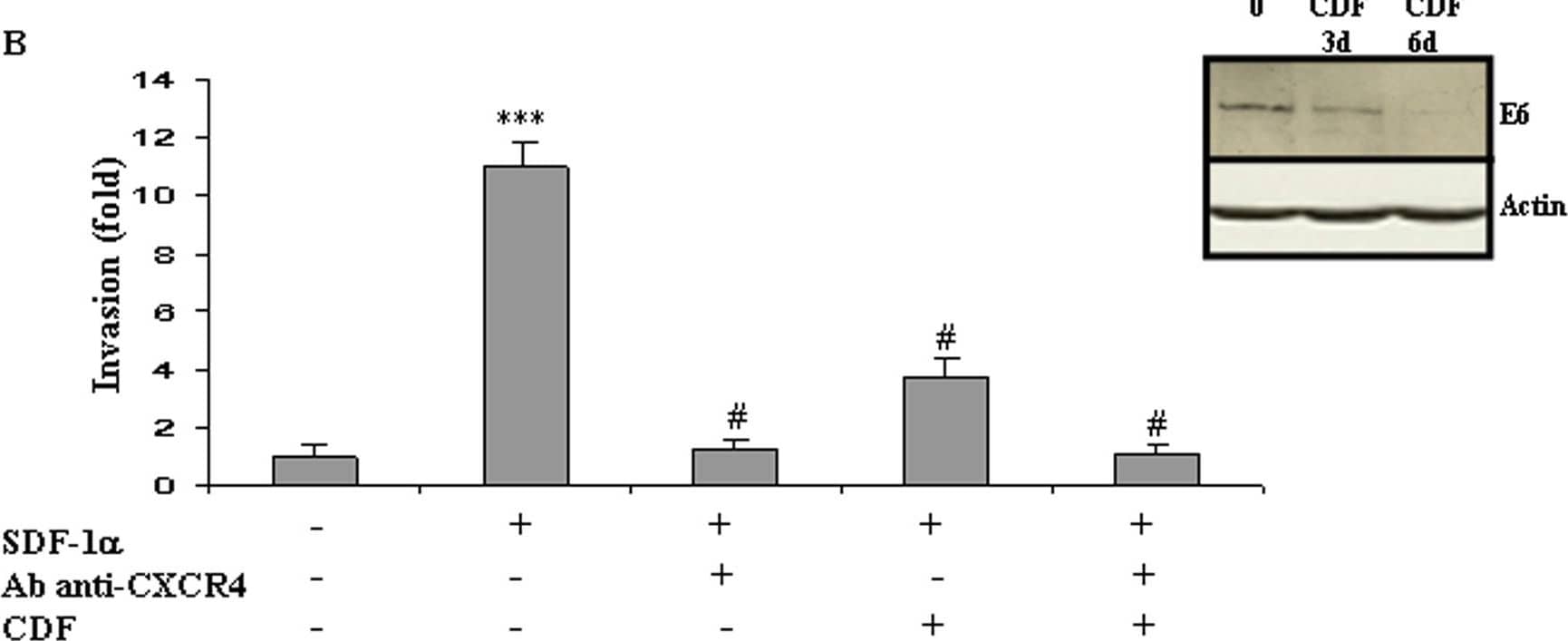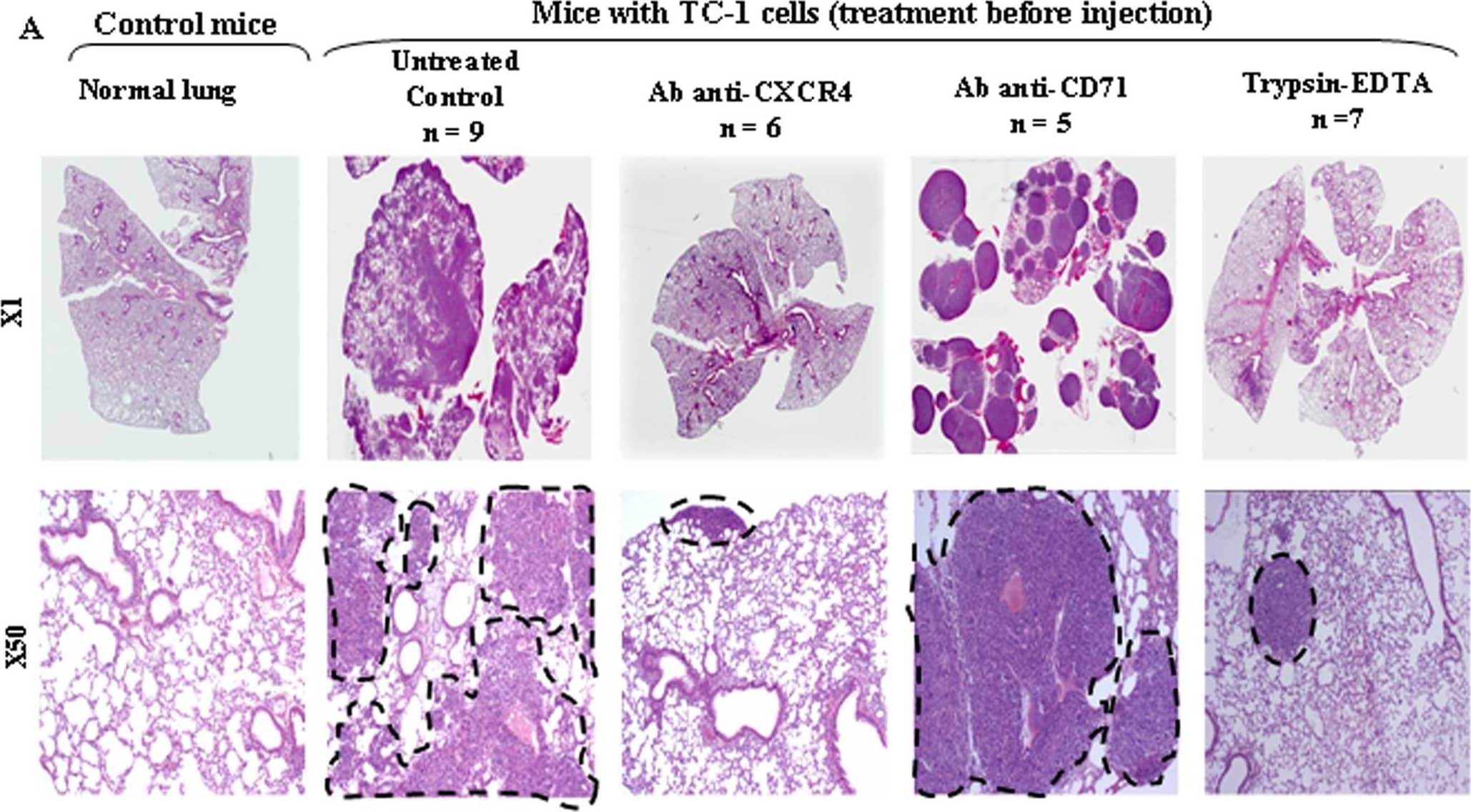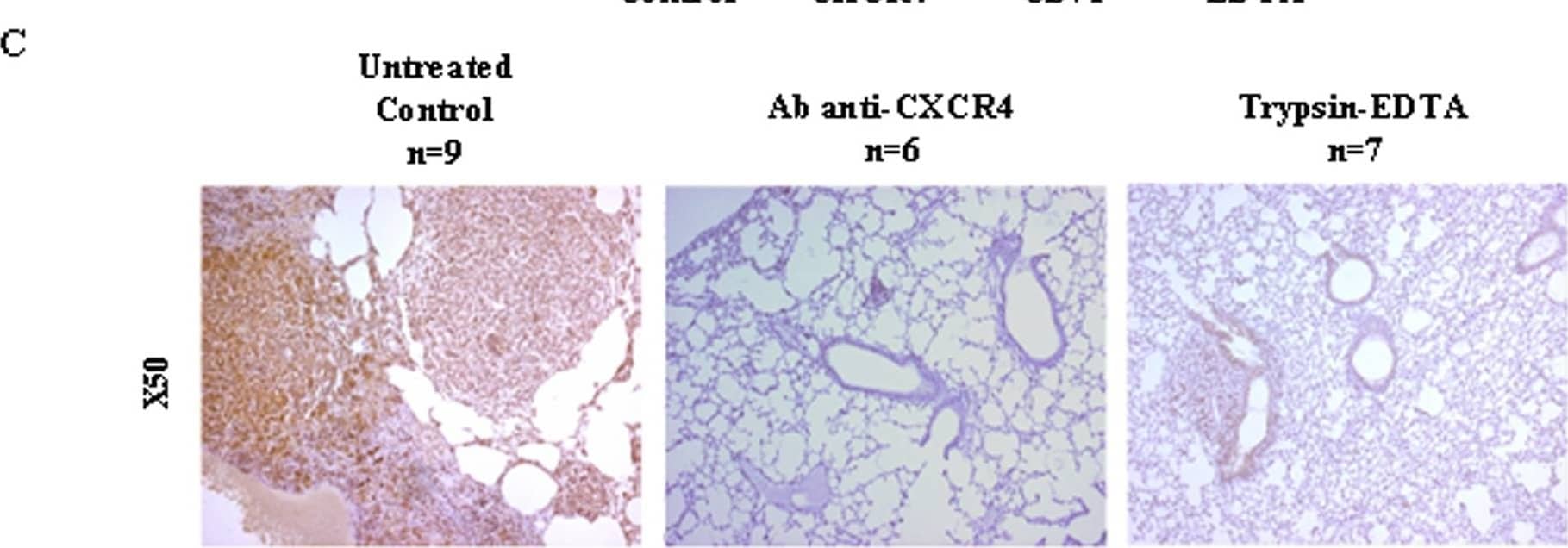Human CXCR4 Antibody Summary
Applications
Please Note: Optimal dilutions should be determined by each laboratory for each application. General Protocols are available in the Technical Information section on our website.
Scientific Data
 View Larger
View Larger
Chemotaxis Induced by CXCL12/SDF‑1 alpha and Neutralization by Human CXCR4 Antibody. Recombinant Human/Feline/Rhesus Macaque CXCL12/SDF-1a (Catalog # 350-NS) chemoattracts the BaF3 mouse pro-B cell line transfected with human CXCR4 in a dose-dependent manner (orange line). The amount of cells that migrated through to the lower chemotaxis chamber was measured by Resazurin (Catalog # AR002). Chemotaxis elicited by Recombinant Human/Feline/Rhesus Macaque CXCL12/SDF-1a (1 ng/mL) is neutralized (green line) by increasing concentrations of Mouse Anti-Human CXCR4 Monoclonal Antibody (Catalog # MAB173). The ND50 is typically 1-5 µg/mL.
 View Larger
View Larger
Detection of Canine CXCR4 by Immunocytochemistry/Immunofluorescence Ectopic expression of CXCR7 and CXCR4 on MDCK cells.(A) MDCK were stably transfected with empty vector (Mock), with CXCR7, CXCR4, a vector coding for a CXCR7 lacking the cytoplasmic C-terminus ( delta CXCR7), and a vector coding for a chimeric CXCR7 containing the DRYLAIV motive of CXCR4. Receptor expression was determined by FACS analysis using saturating antibody concentrations (see Methods). (B) Confocal immunofluorescence analysis of unfixed MDCK cells expressing CXCR7 (upper panels) or CXCR4 (lower panels). Cells also expressed N-ter-Lck mCherry as membrane marker (red fluorescence). Left panels: confocal images of planes cut through intracellular regions of MDCK monolayers. Right panels: x-z planes reconstructed from confocal x-y stacks. For receptor (green) detection anti-CXCR7 (11G8 R&D) or anti CXCR4 (MAB173 R&D) were used. Receptor-bound primary antibodies were revealed with goat anti mouse IgG conjugated with Alexa488 (green fluorescence). Image collected and cropped by CiteAb from the following publication (https://pubmed.ncbi.nlm.nih.gov/20161793), licensed under a CC-BY license. Not internally tested by R&D Systems.
 View Larger
View Larger
Detection of CXCR4 by Western Blot In vitro cell invasion is stimulated by the SDF-1/CXCR4 pathway independently from HPV status.The modulation of E6 expression was monitored using Western-blot in HPV-positive HeLa (A) and TC-1 (B) cells and in HPV-negative B16F10 (C) cells, after 3 and 6 days of incubation with Cidofovir (CDF). Modulation of P53 expression was assessed in HeLa cells after CDF incubation (A). Cell invasion was measured using a Matrigel assay in HeLa (A), TC-1 (B) and B16F10 (C) cells. Recombinant human CXCL12/SDF-1 (100 ng/mL; R&D Systems) was used as chemoattractant and modulation of cell migration was recorded after treatment with CXCR4-blocking antibody or/and Cidofovir (CDF). The invasion rate was determined by counting crystal violet-stained cells. Invasion was stimulated by SDF-1 alpha /CXCR4 independently from the HPV status of the cells but Cidofovir anti-invasive action was restricted to the two HPV-positive cell lines. Three independent experiments with three chambers each time were performed. ***P<0.01, for a statistically true difference, as compared to the untreated group. # P<0.01 compared to SDF-1 alpha -treated group. Image collected and cropped by CiteAb from the following open publication (https://pubmed.ncbi.nlm.nih.gov/19325708), licensed under a CC-BY license. Not internally tested by R&D Systems.
 View Larger
View Larger
Detection of CXCR4 by Immunohistochemistry TC-1 cell lung metastasis is mediated by the CXCR4 in vivo.TC-1 cells (1×106) were injected into mice tail veins either without or with pre-treatment with CXCR4-blocking antibody (2B11), irrelevant antibody (CD71), or trypsin/EDTA. (A). Representative Hematoxylin-Eosin-Saffranin (HES)-satined sections of lungs of mice are shown. Digitization of the whole slides was performed for each animal/treatment type. Histopathological analysis was done after delineation of metastases (dashed line) vs whole lung area (B) on each HES-stained section with the ImageJ software. The lung metastasis indices within each cohort of mice are expressed as fold decrease (+/−SEM) over untreated controls ***P<0.01. (C) Representative sections of CXCR4 immunostaining are shown. Image collected and cropped by CiteAb from the following open publication (https://pubmed.ncbi.nlm.nih.gov/19325708), licensed under a CC-BY license. Not internally tested by R&D Systems.
 View Larger
View Larger
Detection of CXCR4 by Western Blot In vitro cell invasion is stimulated by the SDF-1/CXCR4 pathway independently from HPV status.The modulation of E6 expression was monitored using Western-blot in HPV-positive HeLa (A) and TC-1 (B) cells and in HPV-negative B16F10 (C) cells, after 3 and 6 days of incubation with Cidofovir (CDF). Modulation of P53 expression was assessed in HeLa cells after CDF incubation (A). Cell invasion was measured using a Matrigel assay in HeLa (A), TC-1 (B) and B16F10 (C) cells. Recombinant human CXCL12/SDF-1 (100 ng/mL; R&D Systems) was used as chemoattractant and modulation of cell migration was recorded after treatment with CXCR4-blocking antibody or/and Cidofovir (CDF). The invasion rate was determined by counting crystal violet-stained cells. Invasion was stimulated by SDF-1 alpha /CXCR4 independently from the HPV status of the cells but Cidofovir anti-invasive action was restricted to the two HPV-positive cell lines. Three independent experiments with three chambers each time were performed. ***P<0.01, for a statistically true difference, as compared to the untreated group. # P<0.01 compared to SDF-1 alpha -treated group. Image collected and cropped by CiteAb from the following open publication (https://pubmed.ncbi.nlm.nih.gov/19325708), licensed under a CC-BY license. Not internally tested by R&D Systems.
 View Larger
View Larger
Detection of CXCR4 by Immunohistochemistry TC-1 cell lung metastasis is mediated by the CXCR4 in vivo.TC-1 cells (1×106) were injected into mice tail veins either without or with pre-treatment with CXCR4-blocking antibody (2B11), irrelevant antibody (CD71), or trypsin/EDTA. (A). Representative Hematoxylin-Eosin-Saffranin (HES)-satined sections of lungs of mice are shown. Digitization of the whole slides was performed for each animal/treatment type. Histopathological analysis was done after delineation of metastases (dashed line) vs whole lung area (B) on each HES-stained section with the ImageJ software. The lung metastasis indices within each cohort of mice are expressed as fold decrease (+/−SEM) over untreated controls ***P<0.01. (C) Representative sections of CXCR4 immunostaining are shown. Image collected and cropped by CiteAb from the following open publication (https://pubmed.ncbi.nlm.nih.gov/19325708), licensed under a CC-BY license. Not internally tested by R&D Systems.
Preparation and Storage
- 12 months from date of receipt, -20 to -70 °C as supplied.
- 1 month, 2 to 8 °C under sterile conditions after reconstitution.
- 6 months, -20 to -70 °C under sterile conditions after reconstitution.
Background: CXCR4
CXCR4, also known as CD184, is a G-protein-linked seven transmembrane spanning receptor that binds stromal cell-derived factor-1 (SDF-1). CXCR4 acts as a co-factor for T-cell tropic HIV-1 and -2 viral entry into cells. While primarily a membrane protein, CXCR4 undergoes trafficking and internalization in response to stimulation with phorbol esters and ligand (1). Cytoplasmic and nuclear localization of CXCR4 has been observed in colorectal and renal carcinomas (2,3) and it has been used as the basis of prognosis and metastatic state (3,4,5).
- Orsini, M.J. et al. (1999) J. Biol. Chem. 274:31076.
- Zagzag, D. et al. (2005) Cancer Res. 65:6178.
- Speetjens, F.M. et al. (2009) Cancer Microenvironment 2:1.
- Wang, L. et al. (2009) Oncology Reports 22:1333.
- Amara, S. et al. (2015) Cancer Biomark. 15:869.
Product Datasheets
Citations for Human CXCR4 Antibody
R&D Systems personnel manually curate a database that contains references using R&D Systems products. The data collected includes not only links to publications in PubMed, but also provides information about sample types, species, and experimental conditions.
31
Citations: Showing 1 - 10
Filter your results:
Filter by:
-
Allosteric modulation of the CXCR4:CXCL12 axis by targeting receptor nanoclustering via the TMV-TMVI domain
Authors: García-Cuesta, EM;Martínez, P;Selvaraju, K;Ulltjärn, G;Gómez Pozo, AM;D'Agostino, G;Gardeta, S;Quijada-Freire, A;Blanco Gabella, P;Roca, C;Hoyo, DD;Jiménez-Saiz, R;García-Rubia, A;Soler Palacios, B;Lucas, P;Ayala-Bueno, R;Santander Acerete, N;Carrasco, Y;Oscar Sorzano, C;Martinez, A;Campillo, NE;Jensen, LD;Rodriguez Frade, JM;Santiago, C;Mellado, M;
eLife
Species: Human
Sample Types: Whole Cells
Applications: Flow Cytometry -
Identification of fatty acid amide hydrolase as a metastasis suppressor in breast cancer
Authors: Tundidor, I;Seijo-Vila, M;Blasco-Benito, S;Rubert-Hern�ndez, M;Ad�mez, S;Andradas, C;Manzano, S;�lvarez-L�pez, I;Sarasqueta, C;Villa-Morales, M;Gonz�lez-Lois, C;Ram�rez-Medina, E;Almoguera, B;S�nchez-L�pez, AJ;Bindila, L;Hamann, S;Arnold, N;R�cken, C;Heras-Murillo, I;Sancho, D;Moreno-Bueno, G;Caffarel, MM;Guzm�n, M;S�nchez, C;P�rez-G�mez, E;
Nature communications
Species: Human
Sample Types: Whole Cells
Applications: Flow Cytometry -
Rapid target validation in a Cas9-inducible hiPSC derived kidney model
Authors: Y Shamshirga, A Jonebring, A Svensson, I Leefa, M Bohlooly-Y, M Firth, KJ Woollard, A Hofherr, IM Rogers, R Hicks
Scientific Reports, 2021-08-16;11(1):16532.
Species: Human
Sample Types: Whole Cells
Applications: IHC -
Mechanisms of HIV-1 evasion to the antiviral activity of chemokine CXCL12 indicate potential links with pathogenesis
Authors: M Armani-Tou, Z Zhou, R Gasser, I Staropoli, V Cantaloube, Y Benureau, J Garcia-Per, M Pérez-Olme, V Lorin, B Puissant-L, L Assoumou, C Delaugerre, JD Lelièvre, Y Lévy, H Mouquet, G Martin-Blo, J Alcami, F Arenzana-S, J Izopet, P Colin, B Lagane
PloS Pathogens, 2021-04-19;17(4):e1009526.
Species: Human
Sample Types: Whole Cells
Applications: Binding Assay -
Plasmodium vivax liver stage assay platforms using Indian clinical isolates
Authors: PA Subramani, N Vartak-Sha, S Sreekumar, P Mathur, B Nayer, S Dakhore, SK Basavanna, DM Kalappa, RV Krishnamur, B Mukhi, P Mishra, N Yoshida, SK Ghosh, R Shandil, S Narayanan, B Campo, K Hasegawa, AR Anvikar, N Valecha, V Sundaramur
Malar. J., 2020-06-22;19(1):214.
Species: Human
Sample Types: Whole Cells
Applications: ICC -
Evidence for a pathogenic role of extrafollicular, IL-10-producing CCR6+B helper T cells in systemic lupus erythematosus
Authors: F Facciotti, P Larghi, R Bosotti, C Vasco, N Gagliani, C Cordiglier, S Mazzara, V Ranzani, E Rottoli, S Curti, A Penatti, B Karnani, Y Kobayashi, M Crosti, M Bombaci, JP van Hambur, G Rossetti, R Gualtierot, M Gerosa, S Gatti, S Torretta, L Pignataro, SW Tas, S Abrignani, M Pagani, F Grassi, PL Meroni, RA Flavell, J Geginat
Proc. Natl. Acad. Sci. U.S.A., 2020-03-17;117(13):7305-7316.
Species: Human
Sample Types: Whole Cells
Applications: Flow Cytometry -
Affinity biosensors using recombinant native membrane proteins displayed on exosomes: application to botulinum neurotoxin B receptor
Authors: R Desplantes, C Lévêque, B Muller, M Lotierzo, G Ferracci, M Popoff, M Seagar, R Mamoun, O El Far
Sci Rep, 2017-04-21;7(1):1032.
Applications: Surface Plasmon Resonance -
Agarose Spot as a Comparative Method for in situ Analysis of Simultaneous Chemotactic Responses to Multiple Chemokines
Authors: Mohaned Ahmed, Haneen A. Basheer, Jose M. Ayuso, Djevdet Ahmet, Marco Mazzini, Roshan Patel et al.
Scientific Reports
-
Blockade of hypoxia-induced CXCR4 with AMD3100 inhibits production of OA-associated catabolic mediators IL-1 beta and MMP-13
Authors: Pengcui Li, Jin Deng, Xiaochun Wei, Chathuraka T. Jayasuriya, Jingming Zhou, Qian Chen et al.
Molecular Medicine Reports
-
Novel role for NFAT3 in ERK-mediated regulation of CXCR4.
Authors: Huang, Keven, Kiefer, Christin, Kamal, Adeela
PLoS ONE, 2014-12-16;9(12):e115249.
Species: Human
Sample Types: Cell Lysates
Applications: Western Blot -
CD56(bright)perforin(low) noncytotoxic human NK cells are abundant in both healthy and neoplastic solid tissues and recirculate to secondary lymphoid organs via afferent lymph.
Authors: Carrega, Paolo, Bonaccorsi, Irene, Di Carlo, Emma, Morandi, Barbara, Paul, Petra, Rizzello, Valeria, Cipollone, Giuseppe, Navarra, Giuseppe, Mingari, Maria Cr, Moretta, Lorenzo, Ferlazzo, Guido
J Immunol, 2014-03-19;192(8):3805-15.
Species: Human
Sample Types: Whole Cells
Applications: Flow Cytometry -
Lymphatic specific disruption in the fine structure of heparan sulfate inhibits dendritic cell traffic and functional T cell responses in the lymph node.
Authors: Yin X, Johns S, Kim D, Mikulski Z, Salanga C, Handel T, Macal M, Zuniga E, Fuster M
J Immunol, 2014-02-03;192(5):2133-42.
Species: Human
Sample Types: Whole Cells
Applications: Blocking -
Production of hepatocyte-like cells from human pluripotent stem cells.
Authors: Hannan, Nicholas, Segeritz, Charis-P, Touboul, Thomas, Vallier, Ludovic
Nat Protoc, 2013-01-01;8(2):430-7.
Species: Human
Sample Types: Whole Cells
Applications: ICC -
Functional diversity of human vaginal APC subsets in directing T-cell responses.
Authors: Duluc, D, Gannevat, J, Anguiano, E, Zurawski, S, Carley, M, Boreham, M, Stecher, J, Dullaers, M, Banchereau, J, Oh, S
Mucosal Immunol, 2012-11-07;6(3):626-38.
Species: Human
Sample Types: Tissue Homogenates
Applications: Flow Cytometry -
The miR 302-367 cluster drastically affects self-renewal and infiltration properties of glioma-initiating cells through CXCR4 repression and consequent disruption of the SHH-GLI-NANOG network
Authors: M Fareh, L Turchi, V Virolle, D Debruyne, F Almairac, S de-la-Forest Divonne et al.
Cell Death & Differentiation
Species: Human
Sample Types: Whole Cells
Applications: Immunocytochemistry -
A dynamic inflammatory cytokine network in the human ovarian cancer microenvironment.
Authors: Kulbe H, Chakravarty P, Leinster DA, Charles KA, Kwong J, Thompson RG, Coward JI, Schioppa T, Robinson SC, Gallagher WM, Galletta L, Salako MA, Smyth JF, Hagemann T, Brennan DJ, Bowtell DD, Balkwill FR
Cancer Res., 2011-11-07;72(1):66-75.
Species: Human
Sample Types: Whole Tissue
Applications: IHC-P -
CXCR4 suppression attenuates EGFRvIII-mediated invasion and induces p38 MAPK-dependent protein trafficking and degradation of EGFRvIII in breast cancer cells
Authors: Massod Rahimi, Theodore A. Toth, Careen K. Tang
Cancer Letters
-
CXCR4 and CXCR7 regulate angiogenesis and CT26.WT tumor growth independent from SDF-1.
Authors: Kollmar O, Rupertus K, Scheuer C, Nickels RM, Haberl GC, Tilton B, Menger MD, Schilling MK
Int. J. Cancer, 2010-03-15;126(6):1302-15.
Species: Mouse
Sample Types: In Vivo
Applications: Neutralization -
CXCR7 functions as a scavenger for CXCL12 and CXCL11.
Authors: Naumann U, Cameroni E, Pruenster M, Mahabaleshwar H, Raz E, Zerwes HG, Rot A, Thelen M
PLoS ONE, 2010-02-11;5(2):e9175.
Species: Human
Sample Types: Whole Cells
Applications: ICC -
Chemerin expression marks early psoriatic skin lesions and correlates with plasmacytoid dendritic cell recruitment.
Authors: Albanesi C, Scarponi C, Pallotta S, Daniele R, Bosisio D, Madonna S, Fortugno P, Gonzalvo-Feo S, Franssen JD, Parmentier M, De Pita O, Girolomoni G, Sozzani S
J. Exp. Med., 2008-12-29;206(1):249-58.
Species: Human
Sample Types: Whole Cells
Applications: Blocking -
CCL28 is increased in human Helicobacter pylori-induced gastritis and mediates recruitment of gastric immunoglobulin A-secreting cells.
Authors: Hansson M, Hermansson M, Svensson H, Elfvin A, Hansson LE, Johnsson E, Sjoling A, Quiding-Jarbrink M
Infect. Immun., 2008-04-21;76(7):3304-11.
Species: Human
Sample Types: Whole Cells
Applications: Flow Cytometry -
pVHL co-ordinately regulates CXCR4/CXCL12 and MMP2/MMP9 expression in human clear-cell renal cell carcinoma.
Authors: Struckmann K, Mertz K, Steu S, Storz M, Staller P, Krek W, Schraml P, Moch H
J. Pathol., 2008-03-01;214(4):464-71.
Species: Human
Sample Types: Whole Cells
Applications: ICC -
Vitamin A metabolites induce gut-homing FoxP3+ regulatory T cells.
Authors: Kang SG, Lim HW, Andrisani OM, Broxmeyer HE, Kim CH
J. Immunol., 2007-09-15;179(6):3724-33.
Species: Human
Sample Types: Whole Cells
Applications: Flow Cytometry -
The in vitro migration capacity of human bone marrow mesenchymal stem cells: comparison of chemokine and growth factor chemotactic activities.
Authors: Ponte AL, Marais E, Gallay N, Langonne A, Delorme B, Herault O, Charbord P, Domenech J
Stem Cells, 2007-03-29;25(7):1737-45.
Species: Human
Sample Types: Whole Cells
Applications: Flow Cytometry -
Regulatory T cells can migrate to follicles upon T cell activation and suppress GC-Th cells and GC-Th cell-driven B cell responses.
Authors: Lim HW, Hillsamer P, Kim CH
J. Clin. Invest., 2004-12-01;114(11):1640-9.
Species: Human
Sample Types: Whole Cells
Applications: ICC -
Factors that increase the effective concentration of CXCR4 dictate feline immunodeficiency virus tropism and kinetics of replication.
Authors: de Parseval A, Ngo S, Sun P, Elder JH
J. Virol., 2004-09-01;78(17):9132-43.
Species: Feline
Sample Types: Whole Cells
Applications: Flow Cytometry -
Specific recruitment of regulatory T cells in ovarian carcinoma fosters immune privilege and predicts reduced survival.
Authors: Curiel, Tyler J, Coukos, George, Zou, Linhua, Alvarez, Xavier, Cheng, Pui, Mottram, Peter, Evdemon-Hogan, Melina, Conejo-Garcia, Jose R, Zhang, Lin, Burow, Matthew, Zhu, Yun, Wei, Shuang, Kryczek, Ilona, Daniel, Ben, Gordon, Alan, Myers, Leann, Lackner, Andrew, Disis, Mary L, Knutson, Keith L, Chen, Lieping, Zou, Weiping
Nat Med, 2004-08-22;10(9):942-9.
Species: Human
Sample Types: Whole Cells
Applications: Neutralization -
Mutations at the CXCR4 interaction sites for AMD3100 influence anti-CXCR4 antibody binding and HIV-1 entry.
Authors: Hatse S, Princen K, Vermeire K, Gerlach LO, Rosenkilde MM, Schwartz TW, Bridger G, De Clercq E, Schols D
FEBS Lett., 2003-07-10;546(2):300-6.
Species: Human
Sample Types: Whole Cells
Applications: Flow Cytometry -
Expression of CXCR4 on feline peripheral blood mononuclear cells: effect of feline immunodeficiency virus infection.
Authors: Willett BJ, Cannon CA, Hosie MJ
J. Virol., 2003-01-01;77(1):709-12.
Species: Feline
Sample Types: Whole Cells
Applications: Flow Cytometry -
CXCR4 function requires membrane cholesterol: implications for HIV infection.
Authors: Nguyen DH, Taub D
J. Immunol., 2002-04-15;168(8):4121-6.
Species: Human
Sample Types: Whole Cells
Applications: Flow Cytometry, Neutralization -
EGFR variant-mediated invasion by enhanced CXCR4 expression through transcriptional and post-translational mechanisms.
Authors: Rahimi Massod, George Jessica, Tang Careen et al.
International Journal of Cancer
FAQs
No product specific FAQs exist for this product, however you may
View all Antibody FAQsReviews for Human CXCR4 Antibody
There are currently no reviews for this product. Be the first to review Human CXCR4 Antibody and earn rewards!
Have you used Human CXCR4 Antibody?
Submit a review and receive an Amazon gift card.
$25/€18/£15/$25CAN/¥75 Yuan/¥2500 Yen for a review with an image
$10/€7/£6/$10 CAD/¥70 Yuan/¥1110 Yen for a review without an image




